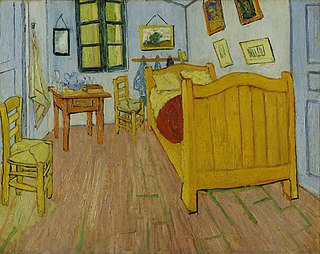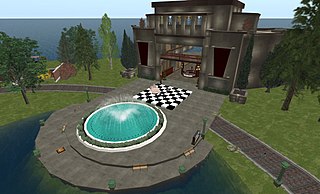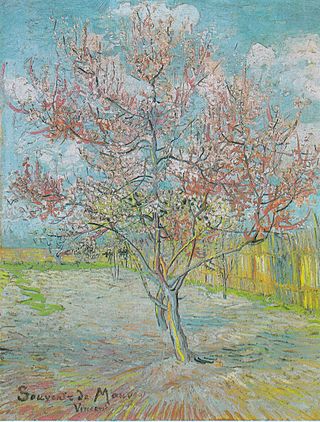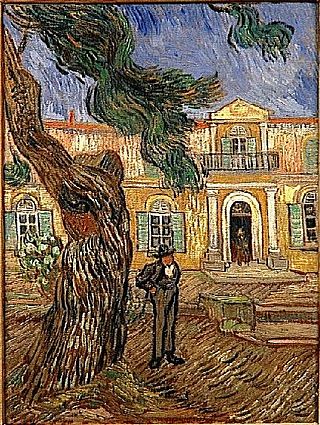Related Research Articles

Vincent Willem van Gogh was a Dutch Post-Impressionist painter who is among the most famous and influential figures in the history of Western art. In just over a decade he created approximately 2100 artworks, including around 860 oil paintings, most of them in the last two years of his life. They include landscapes, still lifes, portraits and self-portraits, and are characterised by bold, symbolic colours, and dramatic, impulsive and highly expressive brushwork that contributed to the foundations of modern art. Only one of his paintings was known by name to have been sold during his lifetime. Van Gogh became famous after his suicide at age 37, which followed years of poverty and mental illness.

A butter churn is a device used to convert cream into butter. This is done through a mechanical process, frequently via a pole inserted through the lid of the churn, or via a crank used to turn a rotating device inside the churn.

Bedroom in Arles is the title given to three similar paintings by 19th-century Dutch Post-Impressionist painter Vincent van Gogh.

The Virtual Library museums pages (VLmp) formed an early leading directory of online museums around the world.

A virtual museum is a digital entity that draws on the characteristics of a museum, in order to complement, enhance, or augment the museum experience through personalization, interactivity, and richness of content. Virtual museums can perform as the digital footprint of a physical museum, or can act independently, while maintaining the authoritative status as bestowed by the International Council of Museums (ICOM) in its definition of a museum. In tandem with the ICOM mission of a physical museum, the virtual museum is also committed to public access; to both the knowledge systems embedded in the collections and the systematic, and coherent organization of their display, as well as to their long-term preservation.

Vincent van Gogh made many copies of other people's work between 1887 and early 1890, which can be considered appropriation art. While at Saint-Paul asylum in Saint-Rémy-de-Provence, France, where Van Gogh admitted himself, he strived to have subjects during the cold winter months. Seeking to be reinvigorated artistically, Van Gogh did more than 30 copies of works by some of his favorite artists. About twenty-one of the works were copies after, or inspired by, Jean-François Millet. Rather than replicate, Van Gogh sought to translate the subjects and composition through his perspective, color, and technique. Spiritual meaning and emotional comfort were expressed through symbolism and color. His brother Theo van Gogh would call the pieces in the series some of his best work.

Flowering Orchards is a series of paintings which Dutch artist Vincent van Gogh executed in Arles, in southern France in the spring of 1888. Van Gogh arrived in Arles in February 1888 in a snowstorm; within two weeks the weather changed and the fruit trees were in blossom. Appreciating the symbolism of rebirth, Van Gogh worked with optimism and zeal on about fourteen paintings of flowering trees in the early spring. He also made paintings of flowering trees in Saint-Rémy the following year, in 1889.

The Wheat Field is a series of oil paintings executed by Vincent van Gogh in Saint-Rémy-de-Provence. All of them depict the view Van Gogh had from the window of his bedroom on the top floor of the asylum: a field enclosed by stone walls just beneath his window and excluded from normal life by the rear wall of the asylum grounds; beyond this enclosure farm land, accompanied by olive groves and vineyards, ran up to the hills at the foot of the mountain range called Les Alpilles.

The Chinati Foundation/La Fundación Chinati is a contemporary art museum located in Marfa, Texas, and based upon the ideas of its founder, artist Donald Judd.
The Paper Project is a fusion project that blends art, science, and technology into engaging 2D and 3D experiences.

The Langlois Bridge at Arles is the subject of four oil paintings, one watercolor and four drawings by Vincent van Gogh. The works, made in 1888 when Van Gogh lived in Arles, in southern France, represent a melding of formal and creative aspects. Van Gogh used a perspective frame that he built and used in The Hague to create precise lines and angles when portraying perspective.
The Institute for Dynamic Educational Advancement (IDEA.org) is a U.S.-based nonprofit organization working in the area of scientific and cultural literacy. The organization was established in 1998 and incorporated in 2002, and has collaborated with museums, schools, nonprofit organizations, and public service projects.
SpicyNodes was a system for displaying hierarchical data, in which a focus node displays detailed information, and the surrounding nodes represent related information, with a layout based on radial maps. It has web (Flash) and mobile (iOS) implementations. It has ended operation as of 1 January 2018

A mobile museum is a museum educational outreach program that bring the museum to the people rather than vice versa. Typically they can be in Recreational Vehicles (RVs) or trucks/trailers that drive to schools, libraries and rural events. Their business model is to use grant or donor support, as they goal is to make the museum exhibit accessible to underserved populations. Below are some examples of mobile museums.

Vincent van Gogh painted at least 15 paintings of olive trees, mostly in Saint-Rémy-de-Provence in 1889. At his own request, he lived at an asylum there from May 1889 through May 1890 painting the gardens of the asylum and, when he had permission to venture outside its walls, nearby olive trees, cypresses and wheat fields.

Wheat Fields is a series of dozens of paintings by Dutch Post-Impressionist artist Vincent van Gogh, borne out of his religious studies and sermons, connection to nature, appreciation of manual laborers and desire to provide a means of offering comfort to others. The wheat field works demonstrate his progression as an artist from the drab Wheat Sheaves made in 1885 in the Netherlands to the colorful and dramatic 1888–1890 paintings from Arles, Saint-Rémy and Auvers-sur-Oise in rural France.

Butterflies is a series of paintings made by Vincent van Gogh in 1889 and 1890. Van Gogh made at least four paintings of butterflies and one of a moth. The metamorphosis of the caterpillar into a butterfly was symbolic to Van Gogh of men and women's capability for transformation.

Saint-Paul Asylum, Saint-Rémy is a collection of paintings that Vincent van Gogh made when he was a self-admitted patient at the Saint-Paul asylum in Saint-Rémy-de-Provence, since renamed the Clinique Van Gogh, from May 1889 until May 1890. During much of his stay there he was confined to the grounds of the asylum, and he made paintings of the garden, the enclosed wheat field that he could see outside his room and a few portraits of individuals at the asylum. During his stay at Saint-Paul asylum, Van Gogh experienced periods of illness when he could not paint. When he was able to resume, painting provided solace and meaning for him. Nature seemed especially meaningful to him, trees, the landscape, even caterpillars as representative of the opportunity for transformation and budding flowers symbolizing the cycle of life. One of the more recognizable works of this period is The Irises. Works of the interior of the hospital convey the isolation and sadness that he felt. From the window of his cell he saw an enclosed wheat field, the subject of many paintings made from his room. He was able to make but a few portraits while at Saint-Paul.

Museum informatics is an interdisciplinary field of study that refers to the theory and application of informatics by museums. It represents a convergence of culture, digital technology, and information science. In the context of the digital age facilitating growing commonalities across museums, libraries and archives, its place in academe has grown substantially and also has connections with digital humanities.

Southampton Street is a street in central London, running north from the Strand to Covent Garden Market.
References
- ↑ "Webexhibits". webexhibits.org.
- ↑ "Beautiful Peacock (2009)" (PDF). Archived from the original (PDF) on 2010-12-15. Retrieved 2011-07-21.
- ↑ Becker, Helaine. "Collaborative teaching in the middle grades: inquiry science". Page 171. Libraries Unlimited, 2005. ISBN 1-59158-191-5.
- 1 2 Pipes, Alan. "Foundations of art + design." Laurence King Publishing, 2003. page 264. ISBN 1-85669-375-9
- ↑ Judd, Carolyn Sweeney. "News from Online: Chemistry and Art." Journal of Chemical Education. Vol 78. No 10. October 2010.
- ↑ Tully, Judd. "Validating Vincent." Pathways: The Novartis Journal. July/Sept 2003. page 44.
- ↑ "Letters Give New View of Artist". nysun.com.
- ↑ Interview of Michael Douma on "Freestyle" with Kelly Ryan on CBC (Canadian Broadcasting) radio, 6-Jan-2006.
- ↑ Gayford, Martin. "The Yellow House: Van Gogh, Gauguin, and Nine Turbulent Weeks in Provence" page 315. Houghton Mifflin Harcourt, 2008. ISBN 0-618-99058-5
- ↑ "TeachersFirst Review - Poetry through the Ages: An Expressive Journey". teachersfirst.com.
- ↑ NASA.gov
- ↑ "Watching the years go by," www.4kids.org. 11/29/1999. Universal Press Syndicate. (The site has since changed ownership.)
- ↑ Los Angeles Times
- ↑ "Site of the Day." The New York Times on the Web. February 7, 2000. For the Chinese Calendar section of the Calendars exhibit.
- ↑ "Lawrence W. Reed on Time on National Review Online". www.nationalreview.com. Archived from the original on 2002-04-07.
- ↑ "Eye on the Environment: Daylight saving time a bright idea". Archived from the original on 2012-04-26.
- ↑ "Lighten Up". washingtonpost.com.
- ↑ Freierman, Shelly (29 March 2001). "NEWS WATCH; Who is Springing Forward and Who Isn't". The New York Times.
- ↑ "Technology - The Times". timesonline.co.uk.
- ↑ "Season, customs have many seeing red". Las Vegas Review-Journal. 20 October 2023.
- ↑ Leah M. Melber, Alyce Hunter. "Integrating Language Arts and Social Studies: 25 Strategies for K-8 Inquiry" page 113. SAGE, 2009. ISBN 1-4129-7110-1.
- ↑ Angel Shanno. "Stick of Butter Cookbook." Cedar Fort, 2007. ISBN 1-59955-009-1. page xii.
- ↑ Franklin, James L. "Show us what you've got." The Boston Globe. Sunday, September 2, 1999. West Weekly Page 2.
- ↑ "Online launches" Min's New Media Report." 9.02.99.
- ↑ "Robin Li and Melissa Ma Science Library".
- ↑ Net Talk Live! feature in show #170 on 23-Nov-1999. This was a syndicated radio show broadcast on television via ABC, CBS, NBC, WB, UPN, Fox and several independents.
- ↑ "Archives & Museum Informatics: Museums and the Web 2010: Papers: Douma, M. et al., Concept Maps for On-line Exhibits: Using SpicyNodes". archimuse.com.
- ↑ Baillargeon, Tara Jean (2008). "Planning, creating, and evaluating eMuseums: a step by step handbook for museum professionals". K-state.edu.
- ↑ Bogomazova, T, and Malevanov, C. "On Representation of a Highlight on the Web: The Amber Room as a Cultural Phenomenon in Progress". WWW10, May 1–5, 2001, Hong Kong. ACM 1-58113-348-0/01/0005. (Cites research from IDEA.)
- ↑ "Cèsar Carreras - Els museus virtuals i el grup Òliba..." uoc.edu.